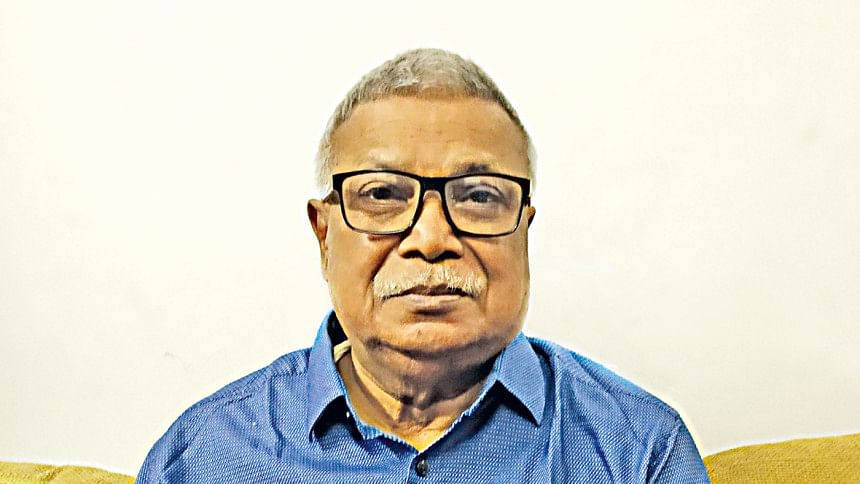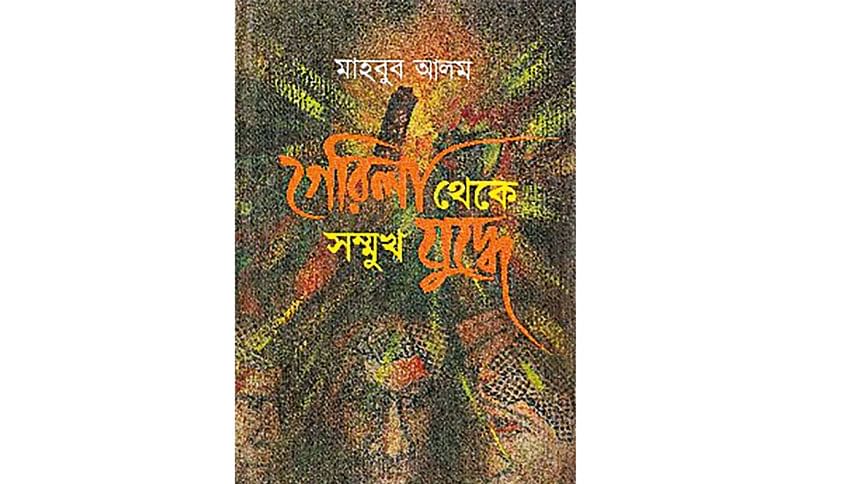“Due to a lack of firsthand experiences of the writers, there is a notable absence of works solely dedicated to our Liberation War”

Mahbub Alam, a valiant freedom fighter, participated in numerous battles against the Pakistani junta during 1971, notably in Sector 6. His two-volume work, "Guerilla theke Sammukh Juddhe," stands as a seminal work on the events of the 1971 war. In this interview with The Daily Star, he reflects on his war experiences and offers insights into the challenges and experiences of writing about the war.
The Daily Star (TDS): What was the situation on the eve of the 1971 war?
Mahbub Alam (MA): I found myself in Rangpur during the Crackdown on March 25th. Witnessing the events unfold, the Pakistan Army emerged from the Rangpur cantonment with tanks and artillery, launching a heavy assault that led to the capture of Rangpur city. Subsequently, systematic killings commenced on April 4th, targeting intellectuals, doctors, and businesspeople in Rangpur. Widespread atrocities occurred throughout the city. I had a part-time role at the Rangpur Public Library, and both the library's secretary and the president of the Rangpur Bar were among those killed.
Following these events, a confrontation ensued to capture the Teesta Bridge. The EPR and the Bangladesh army put up a fierce resistance, resulting in substantial losses for the Pakistani army. I observed numerous trucks and lorries loaded with arms and ammunition passing in front of us. It was during this time that I contemplated joining the war, had I been armed. Biharis, expressing support for the Pak Army, were chanting "Pakistan Zindabad." This encapsulated the overall situation in Rangpur.
TDS: How did you join the war?
MA: In 1971, at the age of 21, I, along with a few friends and seniors, made the decision to cross the border. At that point, we were unaware of whether the Mukti Bahini had been formed. Cycling 200 miles, the four of us entered Coochbehar in India on April 16, 1971. Upon arriving, we encountered over a hundred thousand refugees gathered at Setai, a tiny enclave. With no place to store our four cycles, we planned to head towards Jalpaiguri the following day. I began working at a refugee camp when suddenly, I received news that freedom fighters' recruitment was taking place at Banglabandha. We went there, got selected, and were transported in a lorry by the Indian Army. After spending the entire night in the lorry, we reached the Murti training center.
Upon arrival, we reported, underwent medical checks, and commenced training after grouping. Various wings, such as the Alfa wing, were present. Our senior war mates named these wings after our political leaders, including Tajuddin wing, Mostaq wing, Syed Nazrul Islam wing, Bhasani wing. The entire camp was known as Mujib camp. The Murti camp gained prominence as the most famous camp of the 1971 war, witnessing the graduation of the first short service commission amid the ongoing conflict.
TDS: How was the training period?
MA: Our training spanned four weeks. Following its completion, our assignments on the fronts were determined. We were assigned to the Amarkhana front located at Panchaghar, where 90 individuals, including myself, sought refuge in eight tents. Indian Major Sharma initially oversaw our group, and after two or three days, Major Shankar assumed command.
Our initial attempt at hitting a Pakistani camp across the border failed, leading to some frustration. Stepping forward, I requested to lead our team, and Major Shankar assigned us the task of scouting the Talma bridge. Our objective was to target a Pakistani collaborator, and we successfully executed the operation. This particular incident serves as the starting point for my book.
Major Shankar was impressed with our operation, and subsequently, I assumed leadership in the area. We began our operations in a phased manner, commencing guerrilla fighting in June. By November, we transitioned to the final frontal war. Throughout this period, we experienced both successes and setbacks in guerrilla and frontal warfare. Overall, it was a thrilling time, and I relished every moment; our youth was marked by boundless courage. It remains the most memorable time of my entire life.
TDS: There is a saying that those who fought in the 1971 war lacked the natural skill to express their experiences, and those with writing prowess didn't have authentic experiences or imaginations about the war. Consequently, our literature on the liberation war hasn't been particularly significant. What are your thoughts on this?
MA: I largely agree with this observation. During the war, we didn't witness writers who could eloquently capture the essence of the conflict. However, it remains unclear why some with writing talent didn't participate, perhaps choosing not to risk their lives. As a result, while literature exists on the backdrop of the 1971 war and related issues, there is a notable absence of works solely dedicated to the war due to a lack of firsthand experiences of the writers.
In my own writing, I chose to delve into direct encounters with the war. The thrill and gravity of crossing the border and stepping into occupied Bangladesh were overwhelming. Despite the familiarity of the land, I felt a sense of alienation as our enemies had seized control of everything – the grass, soil, trees, and households. This experience is challenging to comprehend without facing such a situation, and courage plays a pivotal role.
Consider a scenario where a freedom fighter and a Pakistani Army unit are mere meters apart, both heading to confront and annihilate each other. The saying "you kill the enemy; otherwise, he will kill you" takes on profound meaning in such situations. I experienced this reality firsthand, and it profoundly shaped my understanding of the war.

TDS: How did you go about writing your books on the 1971 war?
MA: During my school and college days, I occasionally contributed to literary journals, providing me with some training in the art of writing. Prior to penning my book, my reflections on the 1971 war found their way into The Dainik Sangbad and The Dainik Bhorer Kagoj. It struck me that if we didn't document our experiences, they might be lost forever. In the book's introduction, I emphasized that our stories were grounded in reality, not fantasy. The gravity of the war, the brutality of the Pakistan army and Razakars, and the profound sacrifices of our fighters were unparalleled.
I commenced writing "Guerilla theke Sammukh Juddhe" in 1990, with the first volume published in 1992 and the subsequent volume in 1994 by Jatiya Sahitya Prakash. Interestingly, I had no direct contact with Mofidul Hoque, the publisher; my wife took the manuscript to him. She endured considerable hardship during the 1971 war and when I wrote the book. Hoque read the entire manuscript and decided to publish it. As a government employee, I wrote late at night before bedtime. The reception to my books was heartening, with acknowledgments from notable figures like novelists Shawkat Osman and Mahmudul Haque. Perhaps they found the authentic essence in my book, a dimension often lacking in our literature on the events of 1971.
TDS: With your direct experience of war, can you shed light on the composition of freedom fighters in your sector?
MA: In our sub-sector, there were about 1000 freedom fighters, with only three being graduates. Another contingent comprised approximately 500 individuals from the Army, EPR, and Ansar. The shortage of educated individuals posed a challenge during our war. Educated persons have a better grasp of arms and warfare instructions, especially considering that most commands were given in English. However, many overcame this limitation and evolved into dedicated fighters through hands-on experience and learning by doing. Remarkably, more than seventy percent of our freedom fighters were peasants. I observed that they lacked any desire for power or wealth and abstained from engaging in any immoral incidents.
TDS: Could you elaborate on the war strategy employed in your sector, particularly the shift from guerilla warfare to frontal attacks?
MA: Our initial war strategy revolved around guerilla warfare, emphasizing hit-and-run tactics. Executing this involved careful planning, starting with reconnaissance of the target, observation, and ultimately the execution of orders. Precision was paramount. We typically targeted Pakistani camps located eight to five miles from our hideout. Returning after a successful operation was a gratifying moment, considering the constant awareness of the imminent risk to our lives.
However, the dynamics changed when we transitioned to frontal war on November 22nd. It was an entirely different scenario. Throughout day and night, one couldn't lift their head from bunkers or trenches. Despite this challenging environment, we pushed forward and eventually gained control of Panchagarh, Thakurgaon, and Birganj in the Dinajpur district. We received artillery support from the Indian Army, and during that critical phase, Bangladeshi forces initiated frontal attacks against the Pakistani-occupied positions.
TDS: What transpired for your fellow fighters after the war?
MA: It was a national failure. As a commander, I deeply regretted the fate of my soldiers. When we were instructed to return our arms, anxiety permeated among us. The uncertainty of what would happen next weighed heavily on our minds. We returned home with just one hundred Taka per person, a meager sum considering the precarious financial condition of our state. The Pakistan army had burnt all the money from the bank reserve. In my sector, our sub-sector commander went to Siliguri and borrowed one lac Taka from a Marwari to distribute 100 Taka per person. Consequently, our fellow freedom fighters endured significant economic hardships, and their post-war expectations of securing jobs and societal respect remained unfulfilled. Personally, I returned home with only a pair of shoes and a small medical box.
TDS: What is your perspective on the awards presented to freedom fighters for their heroic roles in the field?
MA: It was another letdown. I cannot fathom why the government did not confer awards on the general freedom fighters. Sector commanders, who did not venture into the fields but stayed in India, and sub-sector commanders, who frequently visited the fields, were the ones nominating individuals. This resulted in sector commanders lacking direct experience of the ground reality. They mostly identified fighters from their own service, neglecting the contributions of general freedom fighters like myself. Consequently, only one fighter from our sub-sector received the Bir Pratik award, and that too, due to some political connections. The majority of awards were bestowed upon freedom fighters from Sectors 2 and 3, recommended by Khaled Mosharraf and KM Shafiullah. Awardees from our sector were few. However, personally, I do not lament the absence of any award for myself.
TDS: How can the next generation of writers create meaningful works on the war of liberation?
MA: In any research, there exists a wealth of data, encompassing primary, secondary, and tertiary sources. Our firsthand accounts, being participants and witnesses to the war, constitute primary data. Those who supported and guided us, or observed our actions during the war, can be considered secondary data. However, individuals without any direct involvement or who merely read books cannot equate their understanding to ours or those who assisted us. A researcher should not overly rely on secondary or tertiary data while disregarding crucial primary data.
My book could serve as a valuable resource for future researchers, offering insights into the period. As we, the eyewitnesses, are gradually fading away, it remains uncertain how the next generation will chronicle the history of the 1971 war.
Unfortunately, I've observed cases where the offspring of freedom fighters show little interest in the war, despite benefiting from their parent's legacy. On the contrary, some individuals not connected to freedom fighter families display great enthusiasm for the war of 1971.
The interview was taken by Priyam Paul.

 For all latest news, follow The Daily Star's Google News channel.
For all latest news, follow The Daily Star's Google News channel. 



Comments